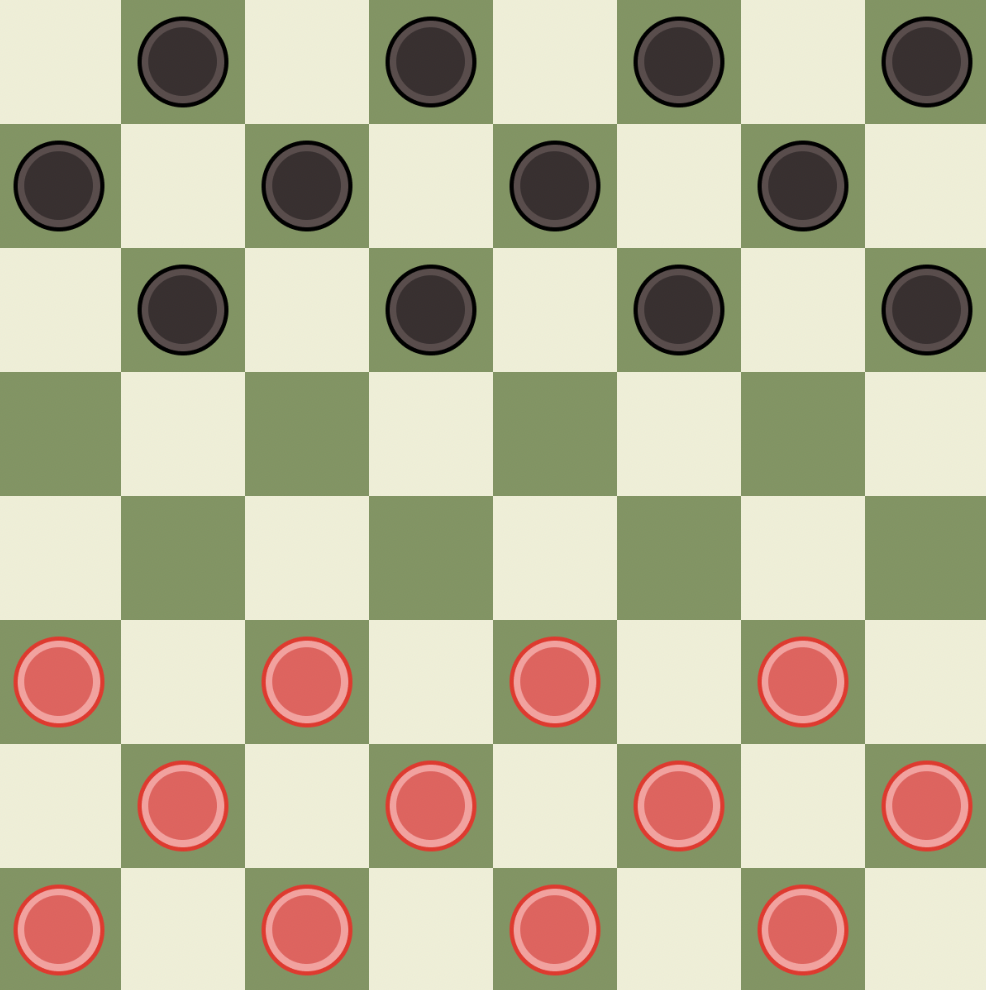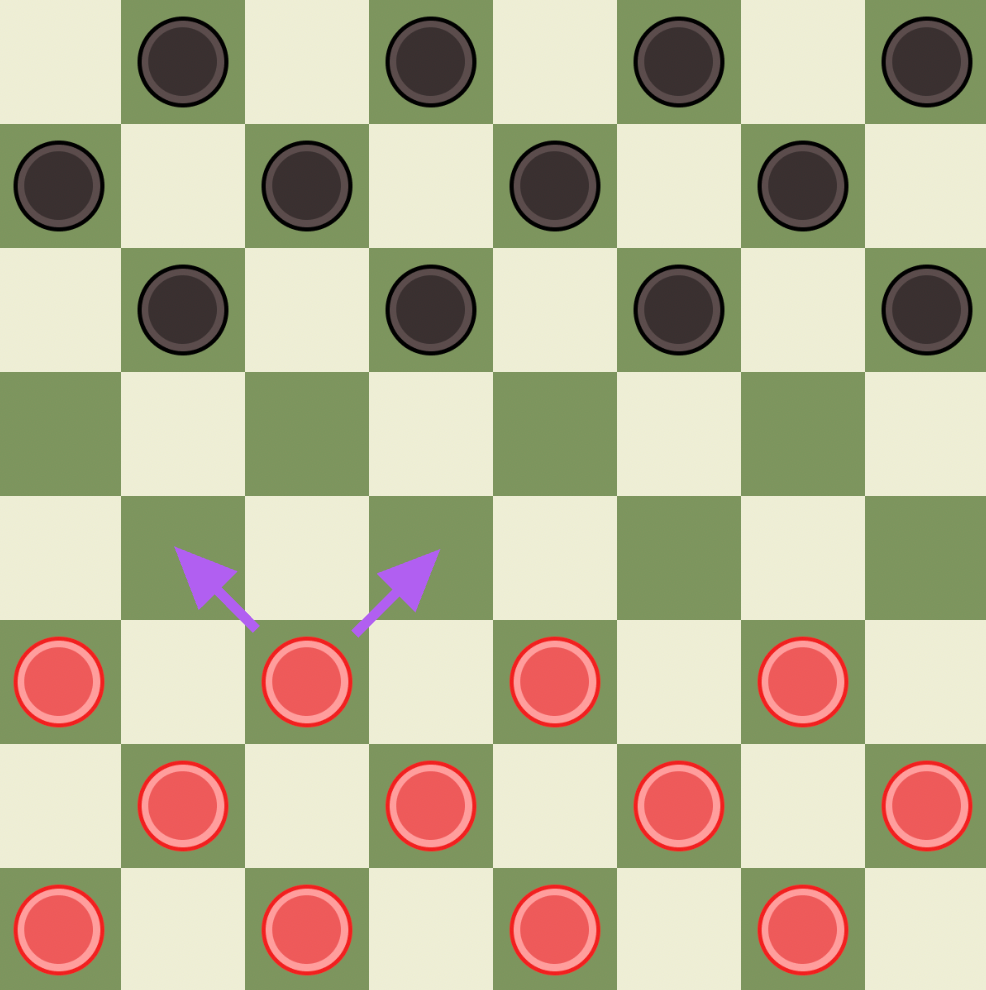How to play Checkers? (American Checkers/ English Draughts)
Game setup
Checkers is played on a 8 by 8 board with alternating dark and light squares. The board is oriented so that a light square is the leftmost square on the row closest to each player from their perspective.
Each player starts with 12 pieces arranged on the 12 dark squares closest to them. Checker pieces are flat disks, often with ridged edges and are generally black and red or black and white. The game setup is identical to that of International Draughts except that the board is smaller and contains fewer pieces.

Objective
The goal of checkers is to beat your opponent by either capturing or blocking all of his/her pieces. A piece is blocked when it has no squares it can move to because the opponent already occupies them.
Game play
Players take turns moving their men across the board while attempting to capture or block all of their opponent’s pieces. Players will try to advance their pieces to the enemies homerow (the row closest to him/her), at which point the piece becomes a “king” and can move in both directions.
Rules
Pieces can only move diagonally
Dark squares are the only valid squares for checker pieces to move to. A piece will always move diagonally by traversing the same number of rows as columns.
Men can only move forward
Men must advance forward in the direction of the opponent’s home row.

Pieces can only move one square when not capturing
During a normal, non-capturing, move, pieces advance to a square diagonally adjacent to their current square.
Pieces can only move to vacant squares
A piece can never land on a square that already has a piece of either color on it.
Pieces are captured when hopped over
Pieces can jump their opponents when they are on a diaganolly bordering square and the square behind it is vacant. Multiple pieces can be jumped in a single turn this way if possible based on the board arrangement.
Men are crowned after reaching the enemy’s home row
When a man reaches the homerow it is "crowned", making it a king with the new ability to move in both the forward and backward directions. The turn ends immediately upon crowning and in physical games the crowning requires a second checker stacked on top of the newly crowned king.
Captures are mandatory
If a capture is available then a player must take it. If multiple captures are available, the player can choose any of them at their discretion and does not need to make the move that captures the most pieces. A piece must continue capturing during the turn until there are no more captures available to it.
A player wins when their opponent no longer has any legal moves or when he/she resigns
A draw occurs when both players agree, automatically after 3 consecutive repeated moves or after 40 moves without a capture or crowning
Strategies and Tactics
Protect your back row
Kings are very valuable in checkers and you should do everything you can defensively to prevent your opponent from gaining any. The best way to prevent this is to keep your homerow well defended. If your pieces are not moved away from their starting positions on the homerow then it is not possible for your opponent to crown a piece. A slightly more aggressive approach is to only leave two non bordering pieces on the homerow which still defends every square but also allows to extra pieces to join the fight.
Take advantage of forced moves
Most of the richness of checkers comes from the forced moves rule which allows you to setup traps to force your enemy into positions he wouldn't have chosen. You can offer up pieces for your opponent to capture when it puts him into a worse situation. Sometimes a forced capture can set you up for a favorable piece exchange like a double or triple capture, other times it will clear the way for one of your men to be crowned.
Fork pieces with your kings
A fork is when a single piece threatens two enemy pieces at once. The opponent can only move one piece to safety and must leave the other one to be captured. Practice recognizing situations where you can force a fork and you'll be able to easily gain a material advantage in most games against unskilled opponents.
Move in twos
A piece is much safer when it is not alone. Try to always move pieces in groups of at least two so the piece is closer to the enemy is always defended by the one farther away.
FAQ
Can you zigzag in checkers?
A piece can zigzag during a hopping move if multiple enemy pieces are available for capture. There’s no rule preventing a piece from changing directions during its hop.
Can a king move straight in checkers?
A king cannot move straight in checkers. It is limited to moving diagonally forwards and backwards.
How does a king get demoted in checkers?
Kings cannot be demoted in American Checkers but can still be captured and removed from the board. Other less common variants like Rubik’s Checkers, Stacking Checkers and Thai Checkers do allow king demotion but the details vary.
What happens if both players can't move in checkers?
It’s not possible for both players to not be able to move in checkers because the game ends as soon as a player no longer has any moves available. You win the game by forcing your opponent into a position where they cannot move either because they have no pieces left on the board or all of their remaining pieces are blocked.
Do you have to jump in checkers if you can?
If a jump is available you must take it. This rule is less well known among casual players and is often ignored.
Can you triple crown in checkers?
You cannot triple-crown in American checkers. A piece can only become a king once and does not get any new abilities if it traverse back across the board a second time.
Can a king jump 2 pieces in checkers?
A king can jump 2 pieces if there is a free square in between them, however, a king cannot jump 2 enemy pieces in a single hope i.e., they are on diagonally bordering squares.
Who usually wins in checkers?
The player who moves first has a slight advantage when playing checkers although a single bad move can offset this edge.
What does the king do in checkers?
A king can move and capture diagonally both forwards and backwards unlike men who can only advance forwards.
Can a king continue to move after being crowned?
The player’s turn ends upon crowning and the king cannot continue to move even if an opponent’s piece is open to capture and the move would otherwise be legal or forced.
Can a piece jump in a circle
A king can jump in a circle in a single turn if the opponent’s pieces are arranged to allow it.
Can a piece jump over itself?
It is not possible for a piece to jump itself.
Can a piece hop over pieces on the same team?
No, only the opponent’s pieces can be hopped over.
Can a piece be jumped over multiple times in the same turn?
A piece can not be jumped over multiple times during a single move because it is considered to be removed from the board the instant it is jumped over.
